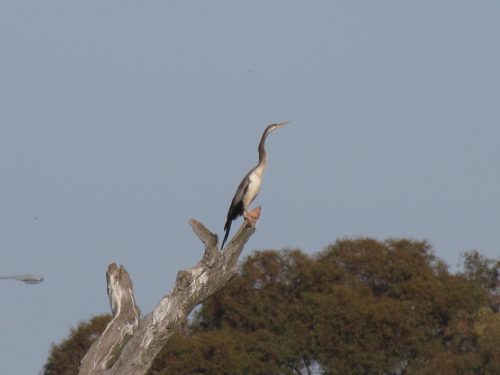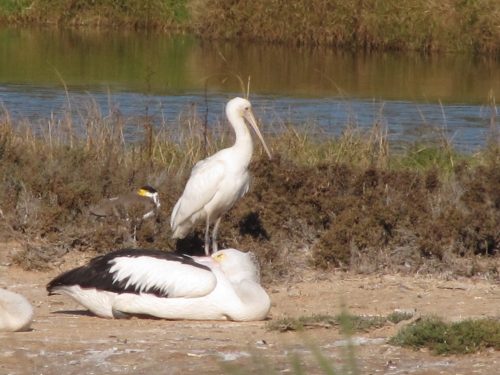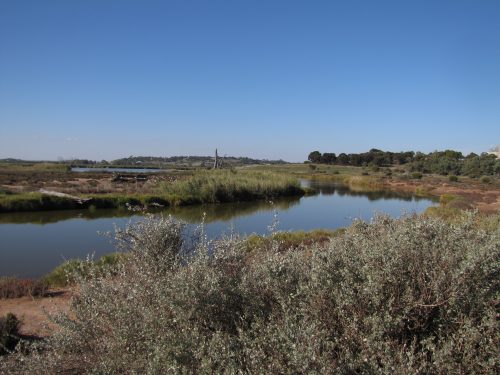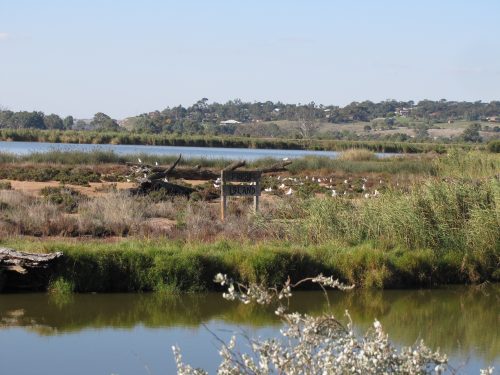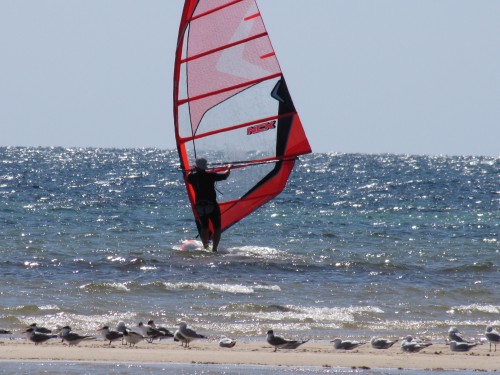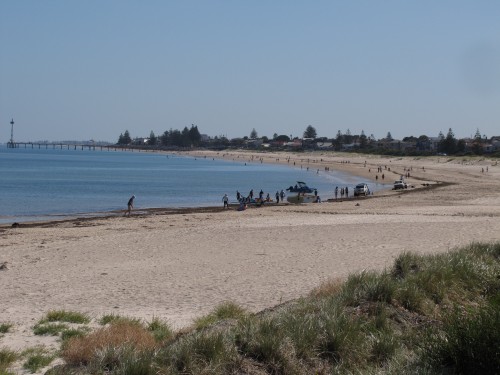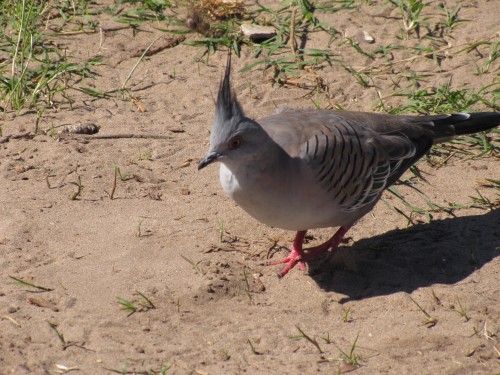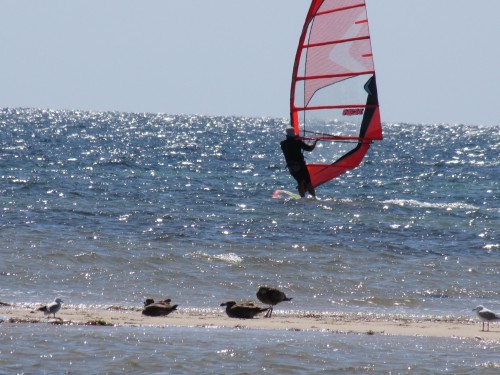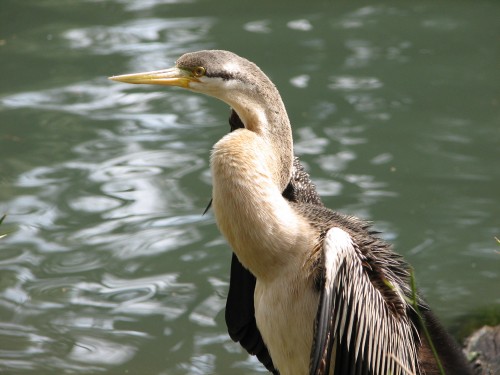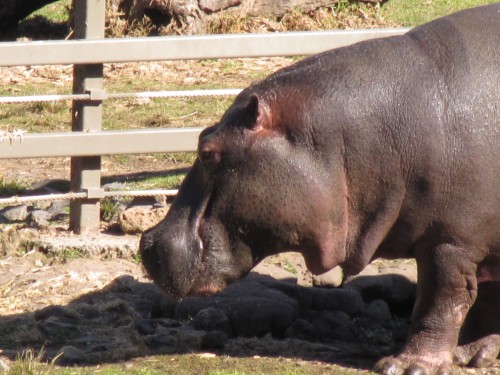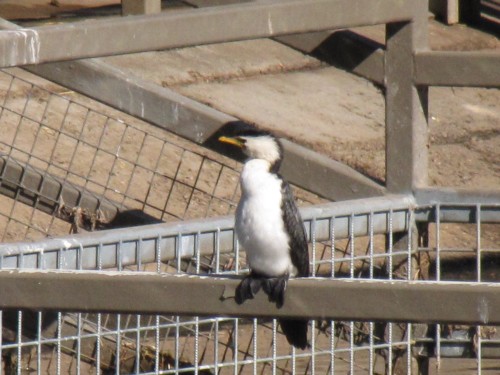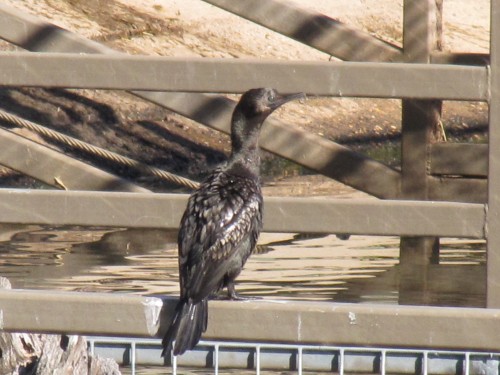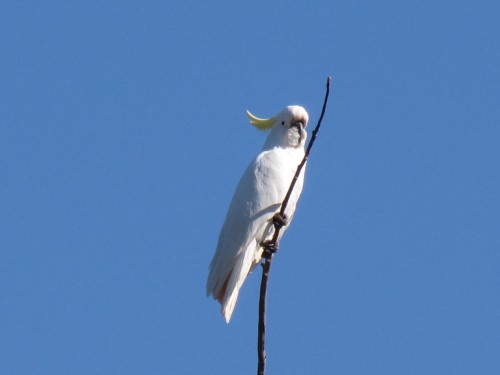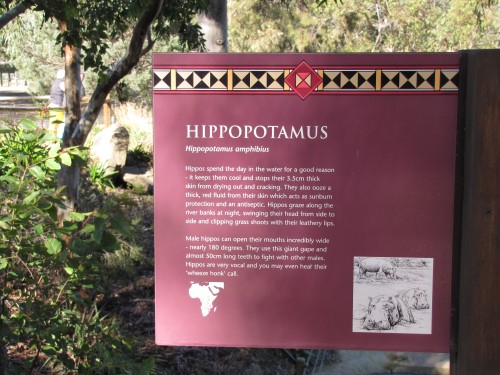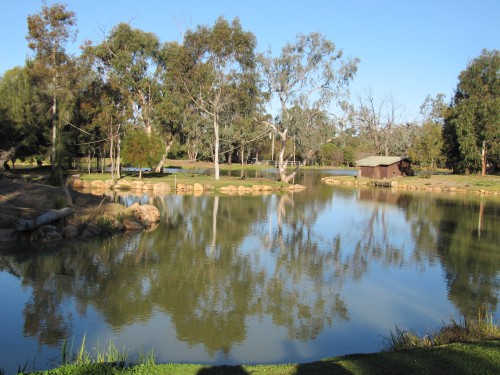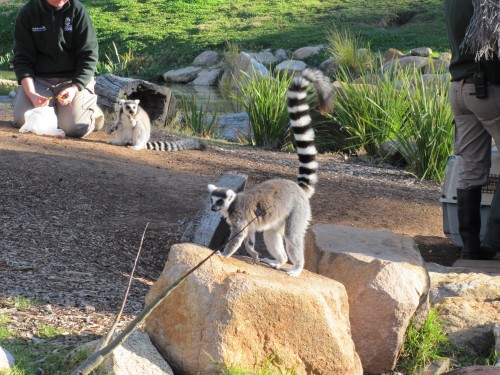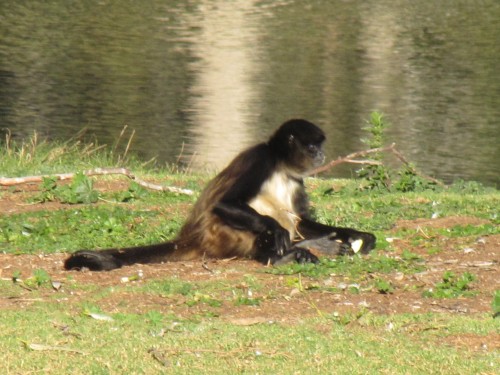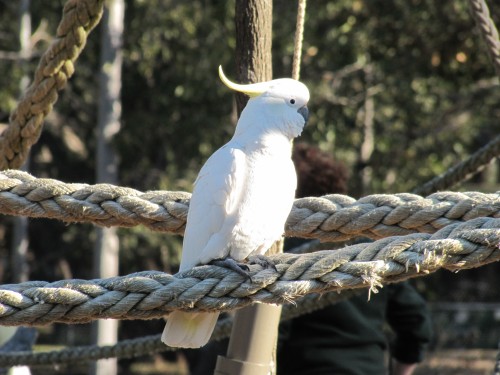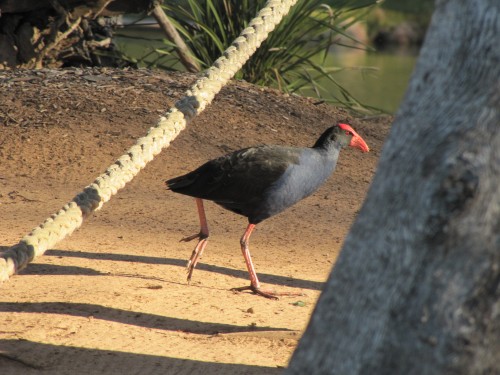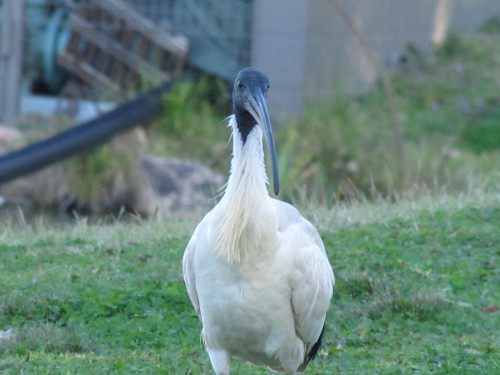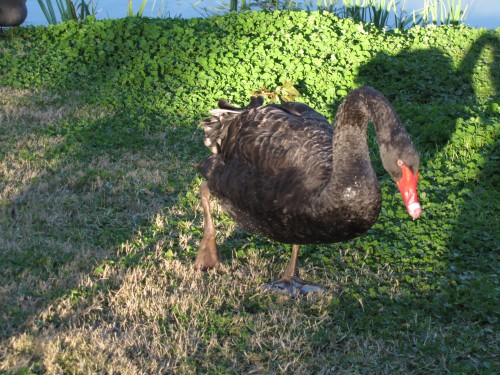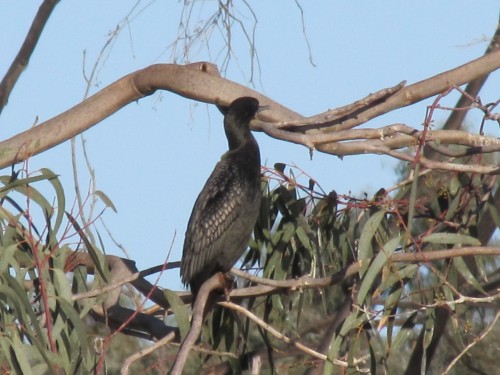Rocky Gully Wetlands, Murray Bridge
Earlier this year I spent a whole afternoon birding at various sites around my hometown of Murray Bridge here in South Australia. One of those sites was the Rocky Gully Wetlands on Mannum Road. I frequently drive past this wetland area, glancing at the lagoons as I drive, but not stopping. I need to change that and linger for a few minutes and take a much more careful note of the birds present. That action is probably safer than birding while driving, anyway.
Bush birds
On this occasion, there were plenty of birds present. Around the lagoons, there were quite a few smaller bush birds in the trees and shrubs that have been planted in the area. This included Red Wattlebirds, White-plumed Honeyeaters, Singing Honeyeaters and New Holland Honeyeaters. I heard a Grey Shrike-thrush calling and several times I heard the resident Superb Fairy-wrens twittering their soft calls to each other. Several Crested Pigeons were present and three Galahs were the only parrots seen at this location. Normally, I would expect to see Little Corellas and several kinds of Lorikeets here. They were absent on this visit.
Waterbirds
On the water of the lagoons or on the several islands I could see quite a few Grey Teal and Chestnut Teal, but interestingly, no Pacific Black Ducks which are very common in this area. A small number of Black-winged Stilts, Eurasian Coots and a solitary Purple Swamphen were seen, along with four Australian Pelicans, a White-necked Heron and a Great Egret. The egret was slowly wading in the shallows looking for a feed. It is a pity I didn’t get a good photo of this bird and its reflections in the water.
Of particular interest were the small group of both Royal and Yellow-billed Spoonbills. I always love seeing these species wherever I go birding. The most interesting sighting, however, was the count of twelve Australasian Darters. While this number is common in many parts of Australia, I have never seen so many in one spot in this region. Probably the most numerous species present were the Silver Gulls, with between 30 and 40 birds around the wetlands.
Further reading:
For each of the species mentioned in this post, I have written one or more articles about them on this site. To read them, go to the search facility in the top right-hand corner and type in the name of the species.
Newsletter:
I also invite you to subscribe to my occasional newsletter (see below the comments).
Good birding,
Trevor
Birding at Brighton Beach
A few weeks ago my wife was attending a convention in the southern parts of Adelaide in South Australia. This is an annual event and we usually go with several other couples, staying in our caravans. Previously this convention was always held in Victor Harbor on the south coast. This year the venue changed to a suburb in Adelaide, so we changed our destination for the weekend to the Brighton Caravan Park. We had never been there before and we were very pleasantly surprised. A nice clean park with new facilities and many new cabins. The van site we had included a cement slab. Our van was a mere twenty steps from the toilets and showers.
Always on these special weekends, I look forward to doing some birding. This can take place at any time during the day while the men are lounging around, eating and drinking tea or coffee, nibbling on biscuits and solving the world’s problems. Well… having an opiinion on world matters.
My plans briefly went astray from the first minute after we had pulled up at the entrance. When I entered the office to check in, the caravan park staff were in a mild state of panic. One of the employees had accidently run over an elderly lady staying in one of the park cabins. She had a cut under one eye from where she hit her face on her glasses, and she was quite shaken. As it turned out, her friend took her to a nearby hospital and I spoke to her the next day. She had recovered well from the experience, though she had a nasty looking black eye. The worker who had backed into her bought her some lovely flowers.
After this small amount of excitement, I checked in and then set up the caravan and annex ready for a few days of relaxation. On Saturday morning, the men in our group of friends sat at the edge of the park overlooking the beach. We were entertained by the local sailing club having a small regatta almost right in front of us. Most of the sailors were juniors and several boats tipped over as the sea breeze stiffened a little.
We enjoyed chatting, drinking our coffee while I did a little casual birding. There were plenty of Silver Gulls and Crested Terns flying past, along with occasional Pacific Gulls and Cormorants. Several Willie Wagtails flittered around on the lawn and nearby low bushes covering the low sand dunes. I could also hear Red Wattlebirds and Rainbow Lorikeets in nearby bushes. We were amused and entertained by the numerous Crested Pigeons feeding on the grass, chasing one another and displaying their feathers.
I will write more about this visit in my next post in a few days’ time.
Good birding.
Trevor.
Watch out darter
Yesterday I took my wife on a drive through the countryside here in South Australia. We had been to Adelaide for an early morning medical appointment so we decided to take an alternative route home and have lunch at Mannum which is a half hour drive north of our home in Murray Bridge. We drove from Burnside to Gumeracha via the Gorge Road, following the picturesque Torrens River Valley.
We stopped at the Big Rocking Horse at Gumeracha for a cup of tea and some lovely freshly baked scones. After our sojourn there we continued on through Birdwood and Tungkillo, heading for Mannum and lunch.
As we were coming down the hill into the small township of Palmer I suddenly had to brake and swerve to miss an Australian Darter sitting in the middle of the lane we were travelling in. I was also conscious of the car close behind me as well. Both of us missed the bird and on checking the rear view mirror I was relieved to see the bird flying off.
Darters are usually seen in or very near water. What on earth was it doing sitting in the middle of a road? This was about 16 km (10 miles) west of the river, but I know there are storage dams on nearby farms in this district. It’s just that I’ve never seen one on a road before.
Of course I didn’t have time to take a photo and there was no safe stopping area either. Besides, this was the first trip I had taken in many years where I totally forgot to take my camera.
The photo above was taken several years ago on the banks of the Murray River which flows through my home town of Murray Bridge in South Australia.
Birds of the hippo enclosure
I think that the hippopotamus is a fascinating animal, but I will resist the temptation to write about it. After all, this site is about Australian birds, so… here we go.
The hippo enclosure a the Western Plains Zoo near Dubbo in New South Wales is a huge one – much larger than enclosures you will see in most zoos. It gives the animals plenty of room to move and live in a more natural environment than would otherwise be the case in captivity. As a part of this provision, the hippos in this zoo have a large water feature to enjoy – it’s really a small lake and they must feel really at home.
Being a water feature, it naturally attracts water loving birds. Two which were hard to overlook were the Little Pied Cormorant and the Little Black Cormorant, both shown in photos below. I’m not sure how many fish they would find in the murky water of the hippo lake, but there they were.
As we were watching the cormorants and the hippos I noticed a Sulphur-crested Cockatoo perched high in the branches of a nearby tree. I’m not sure if the cockatoo was checking out the availability of water from the hippo lake, or looking for a hollow to make a nest. Perhaps it was on guard, ready to warn the flock feeding on the ground of approaching danger.
Birds and animals – Western Plains Zoo
After leaving Sydney and our family with some sense of sadness – the grandchildren wanted us to stay – we travelled to Dubbo. As we entered the rural city we unfortunately had a little bingle in our near new car. Trying to negotiate a round-about I side-swiped another car. I must admit I was at fault; I was in the wrong lane. Happily no-one was hurt, just a little shaken, and both cars were still drivable. I exchanged details with the other driver for insurance claims and we were on our way again 20 minutes later. (Postscript: back home some weeks later the car looks like new again. Our local repairer did a great job.)
By the time we had settled into our cabin in the caravan park it was dark, so any bird watching in the area had to wait. We had a delightful dinner with cousins of my wife that evening, and next morning we gathered at the local crematorium for the funeral of a cousin. While it was a sad occasion, we were pleased to be able to catch up with so many of the family. After lunch together we had a few hours of daylight left, so we drove the short distance to the Western Plains Zoo on the southern edge of Dubbo. This zoo was set up many years ago as an adjunct of Taronga Zoo in Sydney. We had long desired to visit but this was our first opportunity.
We didn’t enter the zoo proper – just the picnic area near the entrance. There is no charge to visit this lawned area. The extensive picnic grounds look over an artificial lake (see top photo above). There are two islands in the lake, each one home to some animals. The closest caters for a family of Ring-tailed Lemurs (see photo above) while the other is home to a group of Black-handed Spider-monkeys (see photo below).
It was feeding time for the monkeys and lemurs, so we sat there in the calm, balmy evening light watching the animals on the islands. As we watched I was able to get a few photos of some of the local bird life, including the Sulphur-crested cockatoo (see photo below) who was obviously a regular visitor to the islands to benefit from any food scraps the animals might overlook. The ropes in the photo are actually there for the entertainment of the lemurs. They also make good perches for a cockatoo.
Just below the cockatoo was a Purple Swamphen, also on the lookout for a free handout. These two birds are wild birds which have come in to the zoo grounds because there is abundant food for the taking. Both probably also check out the picnic grounds for food scraps left behind by people visiting.
The Australian White Ibis (see below) is another species which takes over picnic grounds in search of an easy meal. This individual was alone at the time, but when the zoo is crowded it is probably joined by many more. On our visit the next day we saw large numbers of this species, some of them nesting in the grounds of the zoo (I will show photos of this on another post soon).
In some parks in many places in Australia, the White Ibis has become a serious pest species, harassing people having a quiet picnic by snatching food from them, even to the point of jumping on to a picnic table loaded with human food. Being 65 – 75cm (about 2 feet) in height they can be very intimidating to young children, especially if the children are walking around with food – an ice-cream for example.
Another bird which can be intimidating is the Black Swan (see photo below). This was the only individual we saw that evening, but it came towards where we were sitting in a very determined manner, then waddled up the bank and right up to about a metre from us. When we produced no food it started grazing on the abundant grass all around us. This is another species which is a pest in some parks and picnic grounds. Their beaks can give a nasty bite and their wings, if used, can give some unsuspecting person an nasty whack.
Don’t feed the birds
I’ve written on this topic many times before, but it is worth saying it again, just to educate new visitors to this site. PLEASE DO NOT FEED OUR NATIVE AUSTRALIAN BIRDS. Human food is actually dangerous and even deadly to many of our birds. Added to that risk is what is happening with birds like ducks, ibises and swans: they look to people for free handouts and very quickly become major pests.
If you want to encourage Australian native birds into your life – and into your garden – provide 3 or 4 or more bird baths for them. Plant Australian native plants so they have their natural food, places to shelter and sites for their nests. Read more about this topic here and here.
Of course there are many birds which do not bother people and just get on with their lives. One such species is the Great Cormorant shown below. It is just having a break from searching the lake for fish, frogs and tadpoles.
So this was our first taste of the zoo. We returned the next day for a whole day visit. Photos of the birds we saw – and a few animals too – in the coming days.
Stayed tuned.
